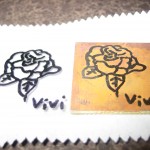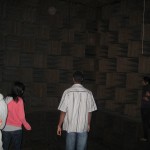-
Pages
-
Categories
-
Archives
7/10/09
Today was the day of our midterm presentations. Our project proposal was to find a successful way to treat HIV by finding a way to attack the virus and keep it from multiplying. The immune system is the body’s natural defense system against foreign substances. Cells that are part of this system are leukocytes, also known as white blood cells. Classified under this category includes helper T-cells and killer T-cells.

Killer T-Cell
Helper T-cells detect foreign substances, and comes in contact with it, triggering the action of the release of cytokines, which are small proteins that stimulate killer T-cells. Once the killer T-cells are triggered, it fights off foreign substances by basically engulfing them.

Helper T-Cell
Once HIV enters the bloodstream, it starts attacking the helper T-cells by attaching itself to it, then injecting its own RNA into the cell. The infected cells will continue to replicate, oblivious that it is actually multiplying the HIV virus itself. In one day, about eight billion new HIV virus particles are created, and about 2 billion infected cells are created and destroyed as well. Since helper t-cells are unable to do their tasks, the cytokines are not released, and and the killer t-cells are not activated at all. HIV, which stands for hman immunodeficiency virus, is not the direct cause of death, but rather extremely weakens the immune system, making it defective from fighting other illnesses. For example, a person cold die from a simple cold. There have been many past failures regarding attempts to treat or cure HIV. The virus cells are actually very malleable and the structure constantly changing and adapting to the environment around it, therefore making it hard for antibodies to recognize the virus. After we finished presenting our idea, we did not really get any feedback from the counseling teams, but hopefully we did fine.

http://www.thebody.com/content/art1788.html
http://users.rcn.com/jkimball.ma.ultranet/BiologyPages/T/Th1_Th2.html
http://www.britannica.com/EBchecked/topic/317764/killer-T-cell
http://www.pbs.org/wgbh/pages/frontline/aids/virus/immune.html
Day 9th.
Today is pretty much the last day, we are currently doing the presentations and I just finished mine. It was a pretty amazing experience being to present the project that we have been working on for so long and everyone’s presentation is pretty solid and creative. =) fun stuff. All the videos that people made are so different from one another. Overall purteh fun. <3
Fluortion-Shaun Herzig, Elana Hubert, Anna Quincy, John Bloore
To come up with our final idea we brainstormed multiple ideas and then whittled down the ideas until we got to one final idea. Our idea was nanobots that make microtears in a persons muscles to promote muscle growth. We took the idea to the counselors at C(n)SI who recommended that we make it more artistic. We added color. Now our project was muscles that glow. From there we created a skin crème that causes skin to glow on impact. And our final project was the skin crème as well as a lactic acid sensor which makes someones skin glow when they use the muscles directly underneath.
Elana:
Wrote script.
Filmed
Actress- anchor
Photoshoped photos
Edited movie
Anna:
Actress – anchor
Wrote script
Filmed
Edited movie
John:
Took pictures
Posed for pictures
Actor
Shaun:
Wrote this paper
Prolouged movie.
Who Did What?
Ryder Moody thought of uses for our product and found images of each use on the internet. These images were then edited with Adobe Photoshop to create the desired glowing effect. He also came up with the way the lens converts infrared signals into visible lights. Because there is infrared light naturally, we had to be sure to use wavelengths that are not emitted by the sun or through the atmosphere. Ryder figured out which spectrum would be able to hold our quantum dot signals, and found images that illustrate this section.
Olivia Kaminsky researched the toxicity of quantum cells and the materials that would prevent the toxins from being emitted into humans. She put together a slide explaining how polymers would be used to incorporate quantum dots into paint, dye, and fabric. Olivia found the video on the production of quantum dots and also organized the bibliography.
Steven was a huge help in hammering out the details of our project. Our project was not one of ease and it was a lot of trouble trying to get it all together. All of use worked hard and asked counselors in order to make sure that our impossible idea is possible. Steven was able to create the concept, the context, and the conclusion. He was also responsible for the introduction to our whole project. Steven was constantly working with counselors in order to make sure that our idea can become possible. When we first started talking about our project, Steven had constant input. Actually, our whole group had constant input and we had so many great ideas, but we never got the one until we came across the idea of quantum dots. Steven helped us narrow our idea and now it has become the great idea it has become.
David researched the previous experiments done with quantum dots. This includes experiments with Indiana University and UCLA. He found that Indiana University did a study in which these dots were attached to biological molecules and when they encounter antigens they light up. For UCLA he found that they put dots in DNA replicating proteins to make genetic engineering more efficient. David also made a slide about how this quantum world would help society psychologically enhance our society and add to our creativity.
Josh has been instrumental in this process working on the project. He came up with plenty good ideas. During the brainstorming session, Josh had an expanse of great ideas, including one about a light show in the clouds, a food microscope inspector, and a sound landscape. He also worked with the other group members well when enhancing these ideas. He tried to be as creative as he could in this process and helped his group come up with a truly unique idea. For the final presentation, Josh opted to organize the PowerPoint, putting all the elements of the Powerpoint on his computer. He also used his art skills to design all the slides (which was a painstaking process). He also animated the slides. Josh wrote the abstract, which was a summary of the whole project. He also wrote two slides on how Quantum Dots function. Josh also made two cover slides.
Day 8: The End
I once had a teacher who, on the first day of class, walked in, declared loudly, “The beginning is the end,” and then promptly sat down to continue class without another word. We were perplexed. Surely he had not intended
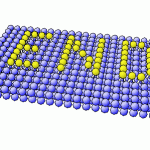 to start the session on such a somber note.However, he had a purpose.
to start the session on such a somber note.However, he had a purpose.
The beginning is often surmised to be the start of the new. However, it is also the end of the old: the end of the known as we enter the unknown. This was how I entered this program. Laden with preconceptions and our stances on right and wrong, we entered the new, releasing the old and the past. I loosened my grip on my staunch beliefs to hear the entire picture. Futuristic notions of large robots and computerized images were defenestrated as we started from the most basic of known biological units: the atom. And there we began, from bottom to top.
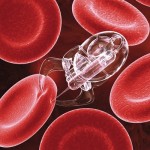
A potential nanobot working in the artery of an organism
As the two weeks passed, a new world was introduced to me. Until now, I had imagined that the microworld was the nanoworld. The fact that a nanometer is a billionth of a meter absolutely mind boggles me. How is it possible that such a “nanocosm” exists in every particle of our being? I’m still perplexed. Perhaps I will never wrap my mind around the idea that our macroworld is shifting towards a world that is invisible to mankind.
However, as the last words of that teacher said, “The end is the beginning.” And while this is the end of the program, it is only the beginning of my scientific journey. The rest is still undiscovered.
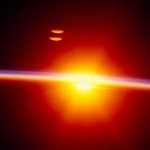
The unpredictable horizon
Links
http://www.zyvex.com/nano/
http://www.kurzweilai.net/meme/frame.html?main=/articles/art0583.html
http://www.merriam-webster.com/dictionary/macrocosm
http://backreaction.blogspot.com/2006/10/end-of-physics.html
http://searchcio-midmarket.techtarget.com/sDefinition/0,,sid183_gci514407,00.html
7/14/09
Today, Victoria Vesna, one of the directors of the Science / Art Nanolab, presented the Daily introduction. We were then given about an hour and a half to work on our final project before lunch. After lunch, experiments were set up for us – FerroFluids and Photolithography. These hands-on labs directly showed me the connection between art and science.
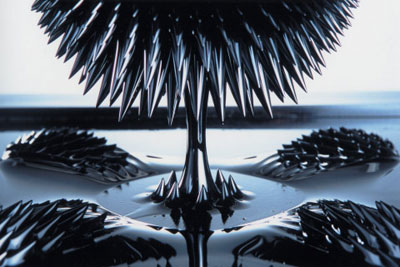
For the FerroFluids, we had to mix many chemicals together, including ammonium hydroxide, FeCl2 and FeCl3. We started by mixing FeCl2 and FeCl3 together. The next step was to slowly drop ammonium hydroxide into the mixture. As we progressed, the liquid slowly started to turn darker, and eventually turned charcoal black. We placed the magnet underneath the beaker the mixture was in, and the magnetite particles in the liquid slowly sunk down to the bottom of the container, attracted to the magnet. The remaining liquid was poured out. The magnetite particles had to be rinsed a couple of times before we could experiment with it, but when we did, they did not seem to work properly. Photolithography was next, allowing us to create our own chips with an embedded personalized image in it. We drew our image into a transparency and fit it into our chip. It was then put under UV rays for about twelve minutes. The chip had to but dipped in two different types of liquids – one that was about 259 degrees celcius – for about forty seconds each. When the liquids were rinsed off, the image was embedded.

http://en.wikipedia.org/wiki/Ferrofluid
http://mrsec.wisc.edu/Edetc/background/ferrofluid/index.html
http://www.youtube.com/watch?v=zpBxCnHU8Ao
http://www.ece.gatech.edu/research/labs/vc/theory/photolith.html
Blog 8: wheeeee
<!– /* Style Definitions */ p.MsoNormal, li.MsoNormal, div.MsoNormal {mso-style-parent:””; margin:0in; margin-bottom:.0001pt; mso-pagination:widow-orphan; font-size:12.0pt; font-family:”Times New Roman”; mso-fareast-font-family:”Times New Roman”;} @page Section1 {size:8.5in 11.0in; margin:1.0in 1.25in 1.0in 1.25in; mso-header-margin:.5in; mso-footer-margin:.5in; mso-paper-source:0;} div.Section1 {page:Section1;} –>
/* Style Definitions */
table.MsoNormalTable
{mso-style-name:”Table Normal”;
mso-tstyle-rowband-size:0;
mso-tstyle-colband-size:0;
mso-style-noshow:yes;
mso-style-parent:””;
mso-padding-alt:0in 5.4pt 0in 5.4pt;
mso-para-margin:0in;
mso-para-margin-bottom:.0001pt;
mso-pagination:widow-orphan;
font-size:10.0pt;
font-family:”Times New Roman”;
mso-ansi-language:#0400;
mso-fareast-language:#0400;
mso-bidi-language:#0400;}
Wow! It has already been two weeks, yet it only has been two weeks. It seems as if these two weeks has been a blur, but at the same time, what happened just last week seems as if it were a month ago. It is amazing how many things we have experienced. Nanotechnology has ramifications so many different fields that it is impossible to fully experience it without learning about dozens of other fields at the same time.
When I first joined this program, I saw that is said science and art, which I thought was a bit weird, but I sounded very interesting. I considered myself a scientist but definitely not an artist Even as recently as a week ago, I wasn’t sure that science and art were coming together. However, I realize now that science and art aren’t as different after all. Both scientists and artists are both searching for the same thing, the beauty in the universe. Ever since the science and art fields broke apart a couple hundred years ago, they have been moving closer together and now, they are coming closer than ever with hundreds and thousands of collaborations between scientists and artists today.
The topics we covered during this program were mainly science-based, but also had major roles in the art field. The lab visits I enjoyed the most were the plasma research center and the anechoic chamber. The Ferrofluid and photolithography were amazing and reinforced the aspect that science and art are coming closer together.
Day 4.
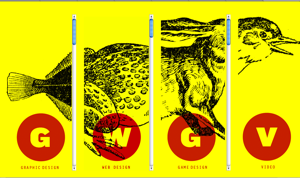 Today was quite a tiring day. I think my favorite part was the DESMA presentations that we saw. Each one was creative in their own way and it really sparked up a lot of interest. I am interested in Graphic Design to begin with, and this allowed me to being thinking about focusing with flash and use it more as a recreational and begin doing small projects with it. My interest got sparked up, and allowed me to come up with the idea for the final video.
Today was quite a tiring day. I think my favorite part was the DESMA presentations that we saw. Each one was creative in their own way and it really sparked up a lot of interest. I am interested in Graphic Design to begin with, and this allowed me to being thinking about focusing with flash and use it more as a recreational and begin doing small projects with it. My interest got sparked up, and allowed me to come up with the idea for the final video.
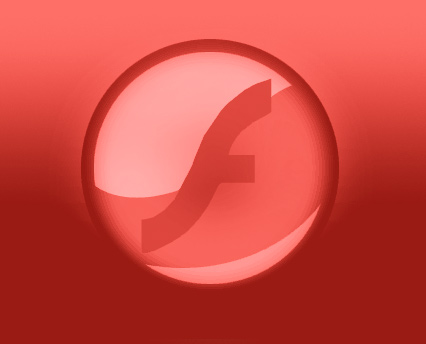
Everyone’s ida and coception of the things nanobots could do was amazing ther
e is a lot to be done with the nanotechnology that we can have in the future. That reminds me that we saw the video of the nanophone that changes into so many others. I think that nano science is going to have a lot of advantages in the future. Might go out and buy some nanosocks. 😉
Today we also presented our midterm presentations which where a little bit of a mess in my opinion because we where still not sure on what we wanted to really do. What we came up with was way different that what our final outcome was. I think that was okay though because it is now finally done and completed.

http://www.adobe.com/devnet/flash/learning.html
http://artsci.ucla.edu/
7/13/09
Today’s daily introduction was about shapes in general, and classified under the category of shapes included shapes in nature. Crystals are atoms arranged in a specific packing sequence, and opals are clusters of nanospheres that reflect light. When you think about it, the solar system actually represents the shape of the atom.

Our perception of shape is relative to our temporal perspective. Now, look at your surroundings. A seemingly static surface of an object is actually in constant motion at a molecular scale. Our DNA is very special. It has a very specific molecular structure that helps us copy our own genetic information. DNA includes systems, such as the ribosome, tRNA, and the mitochondrial membrane. If you pay close attention, structures, such as buildings, are simply combinations of shapes. After the lecture, we were allowed one hour to work on our final project. From one to five o’ clock, we visited the Fowler Museum, the UCLA Plasma Research Center, and the History and Special Collections for the Sciences.

At the Fowler Museum, we learned about the meaning of the pictures painted by the Australian aborigines depicted by the symbols. They were always either very abstract or direct. It was also very noticeable that every painting was symmetrical and had earthy tones.

In the UCLA plasma research center, we were first taken to the machine downstairs, then to the bigger machine upstairs, where I was able to see the beam of red light traveling around. The last place we visited was the History and Special Collections for the Sciences. Right when I stepped in, I was struck by the amount of antique items that were held there. The librarian had so many antiques, including Darwin’s Origins of Species and one of Florence Nightingale’s letters.
http://science.howstuffworks.com/cellular-microscopic-biology/dna.htm
http://www.physics.ucla.edu/psti/
http://www2.library.ucla.edu/specialcollections/biomedicallibrary/index.cfm
http://www.literature.org/authors/darwin-charles/the-origin-of-species/

